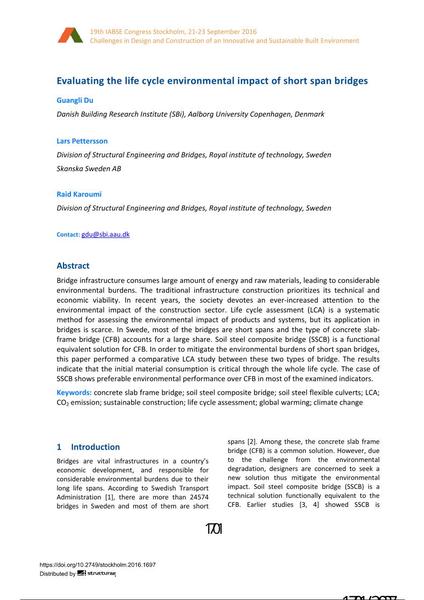Evaluating the life cycle environmental impact of short span bridges

|
|
|||||||||||
Bibliographic Details
| Author(s): |
Guangli Du
(Danish Building Research Institute (SBi), Aalborg University Copenhagen, Denmark)
Lars Pettersson (Division of Structural Engineering and Bridges, Royal institute of technology, Sweden Skanska Sweden AB) Raid Karoumi (Division of Structural Engineering and Bridges, Royal institute of technology, Sweden) |
||||
|---|---|---|---|---|---|
| Medium: | conference paper | ||||
| Language(s): | English | ||||
| Conference: | IABSE Congress: Challenges in Design and Construction of an Innovative and Sustainable Built Environment, Stockholm, Sweden, 21-23 September 2016 | ||||
| Published in: | IABSE Congress Stockholm, 2016 | ||||
|
|||||
| Page(s): | 1701-1707 | ||||
| Total no. of pages: | 7 | ||||
| Year: | 2016 | ||||
| DOI: | 10.2749/stockholm.2016.1697 | ||||
| Abstract: |
Bridge infrastructure consumes large amount of energy and raw materials, leading to considerable environmental burdens. The traditional infrastructure construction prioritizes its technical and economic viability. In recent years, the society devotes an ever-increased attention to the environmental impact of the construction sector. Life cycle assessment (LCA) is a systematic method for assessing the environmental impact of products and systems, but its application in bridges is scarce. In Swede, most of the bridges are short spans and the type of concrete slab- frame bridge (CFB) accounts for a large share. Soil steel composite bridge (SSCB) is a functional equivalent solution for CFB. In order to mitigate the environmental burdens of short span bridges, this paper performed a comparative LCA study between these two types of bridge. The results indicate that the initial material consumption is critical through the whole life cycle. The case of SSCB shows preferable environmental performance over CFB in most of the examined indicators. |
||||
| Keywords: |
LCA life-cycle analysis life-cycle assessment (LCA) sustainable construction CO2 emission climate change global warming concrete slab frame bridge soil steel composite bridge soil steel flexible culverts
|
||||
